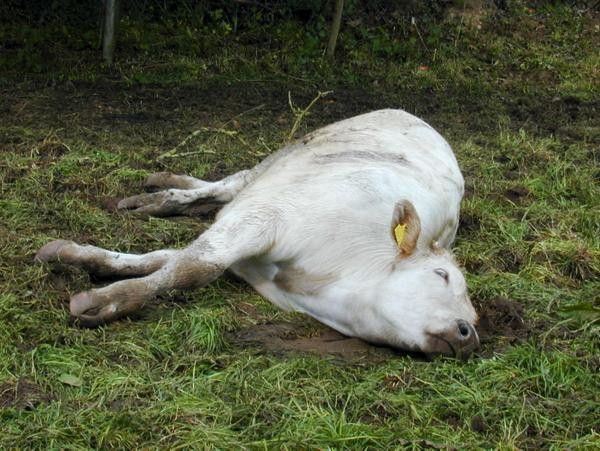We smallholders are a tough bunch, most of us wouldn’t let the odd cut or scratch bother us. By the nature of our lifestyle, smallholders are exposed to injuries or even bites from our animals. Because of this, it is important to keep a record of when last we had a tetanus shot.
Our animals are just as vulnerable to puncture wounds from standing on nails or scratches from rusty wire, as well as inherent danger when they are dehorned, castrated, tattooed or have their tails docked.
Tetanus or lockjaw is caused by a toxin produced by bacteria which are present in the soil, as well as the intestinal flora of humans and animals, in faeces, on human skin and on teeth. The bacterium Clostridium tetani survives in the environment for long periods of time. It enters the body through wounds, particularly puncture wounds if the wound is dirty and is not affected or destroyed by disinfectants. Puncture wounds on the sole of the foot are common sites of infection.
Both humans and animals can contract tetanus.
The incubation period (the time from injury to the onset of the first symptom) can be as short as 24 hours and as long as many months. The average time period is 7-10 days. Typically, the further the injury from the central nervous system, the longer the incubation period.
Tetanus toxin affects the nerves around the site of injury or wound and then it travels to the spinal column and from there attacks nerves controlling the muscles of the body. This causes progressively worsening muscular stiffness and spasm. The affected person or animal will become stiff and have difficulty moving and eating.
Tetanus in animals

In horses the third eyelid (membrana nictitans, a membrane which can be easily seen at the inner corner of the eye) starts to protrude across the eye, particularly if the horse is startled. The tail is often held out straight and the horse develops an anxious expression because of facial muscle spasm. Any stimulus such as loud sound, bright light or touch can exacerbate the signs. The horse may sweat. In advanced cases the horse will collapse with spasms, convulsions and death from respiratory failure.
In sheep, symptoms of tetanus infection include muscle stiffness and spasms, bloat, panic, uncoordinated walking and movements, and the inability to eat and drink.
Because sheep undergo several maintenance procedures, such as castration, ear-marking, tail-docking, dehorning and debudding, they are highly at risk for contracting tetanus.
Amongst pigs the most common source of infection is castration. An infected pig is hypersensitive, sometimes convulsive, shows stiffness of legs and muscles, an erect tail and muscular spasms of the ears and face.
In the case of cattle, infection might occur during castration or dehorning. Stiffness and reluctance to move are normally the first signs. There might be twitching and tremors of the muscles, lockjaw, prominent protruding third eyelid and unsteady gait with stiff held out tail. Affected cattle are usually anxious and easily excited by sudden movements or handling.
If diagnosed early, treatment is aimed at destroying the bacteria so that no more toxin is produced, and reducing the effects of the toxin that has already been produced. Large doses of antibiotics, usually penicillin, are used in conjunction with Tetanus Antitoxin injections. However mortality rates amongst livestock with tetanus are very high.
Inoculation
Fortunately there is a vaccine that helps to prevent tetanus.
Animals which are vaccinated for the first time at the age of three months or older should receive two inoculations at an interval of 4-6 weeks. Thereafter they are inoculated only once a year to maintain immunity.
To protect animals younger than three months at the time of docking, castration and possible navel infection after birth, a first-time mother should be inoculated for the first time six weeks into pregnancy and again at two weeks before giving birth, and thereafter only once annually 2-4 weeks before the young are born. In this manner the young obtain colostral immunity which will protect them for a period of 8-10 weeks. At the age of three months they can be inoculated themselves.
Horses are injected intramuscularly and other animals subcutaneously.
Preventing tetanus
There are also preventative measures that we can take. Ensure that fence posts and gates are rust-free and painted. Check your fences regularly for broken wires that might scratch an animal or human.
Do not leave gardening implements, particularly forks or rakes, lying around where a person or animal might stand on them.
Constantly check your fields for pieces of wire, nails or tins. Never assume that your fields are danger free. Any seasoned smallholder can tell you that they have lived on the same plot for twenty five years and are still finding bits of wire and inexplicable pieces of rusty metal in their fields. Some of us also suffer thoughtless neighbours or passers-by who toss all manner of strange things over the fence.
In terms of human treatment against tetanus, you need to consider it if the wound is deep or it contains dirt or a foreign object. Risk of tetanus from a bite from an animal would only apply when the bite is deep and the skin is broken.
Nowadays South African children are vaccinated against tetanus and it is recommended that people receive a booster shot every ten years. If you have had a tetanus shot less than five years ago you won’t need another one.

